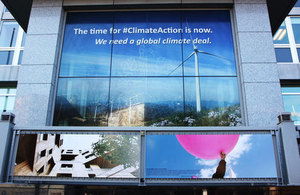UK's low-carbon innovations on display in Ottawa
New photo exhibit from the British High Commission highlights how the UK is working to build a low-carbon future.

British High Commission, Ottawa, Canada
The British High Commission in Ottawa unveiled a photo display on Monday (9 November), highlighting cutting edge UK innovations in low carbon technology, as the world prepares for the COP21 Climate Change Summit in Paris later this month.
Visible on the front of the High Commission building itself, along the high traffic section of 80 Elgin Street, the display is not only a demonstration of UK expertise green technology but a reminder of the UK’s commitment to a global climate deal in Paris.
A complementary online exhibit has also been published.
British High Commissioner Howard Drake said:
“Climate change is a serious challenge that transcends borders. It requires international cooperation, innovative thinking, and bold action. As a leader on climate change action and the transition to a low carbon economy, the United Kingdom is committed to a global, legally binding deal at the Paris climate summit in December that keeps the goal of limiting global temperature rise to 2°C within reach.”
“The low carbon transition is already in motion, and the UK is doing its part. Britain has cut carbon emissions by 30 percent since 1990 and was the first country in the world to set a long-term target, consistent with scientific advice, into law.”
“The photos on display are just a few examples of British ingenuity in action, creating innovative solutions to a global problem.”
The display will run until December and include the following technologies:
Wind farm in Rhondda Cynon Taff, Wales
Built in 1993, the Taff Ely Wind Farm consists of 20 turbines and generates enough electricity to power over 4,250 homes each year. In Britain, onshore wind energy has deployed successfully to date. Renewables provided nearly 20 percent of the UK’s electricity in 2014, well on track to the UK’s 2020 target of 30 percent.
OpenHydro’s tidal energy turbine being prepared for deployment in Orkney, Scotland
Once installed on the seabed, this Open-Centre Turbine will silently and invisibly harness the power of changing tides. With some of the world’s best wave and tidal resources, and a quarter of global marine energy technology projects led by British businesses, the UK is a leader in this field.
Drayson racecar – the world’s fastest, zero-emissions electric car
Designed by Drayson Racing Technologies, the Lola Drayson B12/69 EV shows what is possible for the development of next generation electric car technologies. Electric, hybrid, and hydrogen fuel cell vehicles will play a growing part in the transition to a low carbon future. The UK Government has committed £900 million to support the deployment of low emission vehicles, including expanding the country’s network of charging stations.
The Cube residential building in London, England
Designed by Hawkins\Brown, this 10-storey apartment block is primarily constructed with cross-laminated timber (CLT), with steel elements and a reinforced-concrete core. Compared to concrete, CLT has a lower carbon footprint and results in less waste.
The Met Office in Exeter, Devon, England
Effective action on climate change requires the right information and expertise to understand and find solutions to the problem. The Met Office Hadley Centre conducts world-class scientific research on the climate and works with providers of infrastructure to understand and plan for climate variability and impacts. This ensures that essential sectors like electricity, rail, and roads are resilient to severe weather.
Shell Quest Carbon Capture and Storage project in Alberta, Canada
British low carbon innovation is taking place in Canada too. The Quest Carbon Capture and Storage (CCS) Project will reduce carbon emissions from oil sands operations by more than one million tonnes a year, permanently storing the pollution deep underground. According to the International Energy Agency, CCS could provide one-sixth of total carbon emissions reductions by 2050.
Further information
Follow the British High Commission Ottawa on Twitter @UKinCanada Follow the Foreign Office on Facebook
Media enquiries
Tom Walsh
80 Elgin Street
Ottawa Ontario K1P 5K7
Canada
Email tom.walsh@fcdo.gov.uk
Office +1 613 868 9296